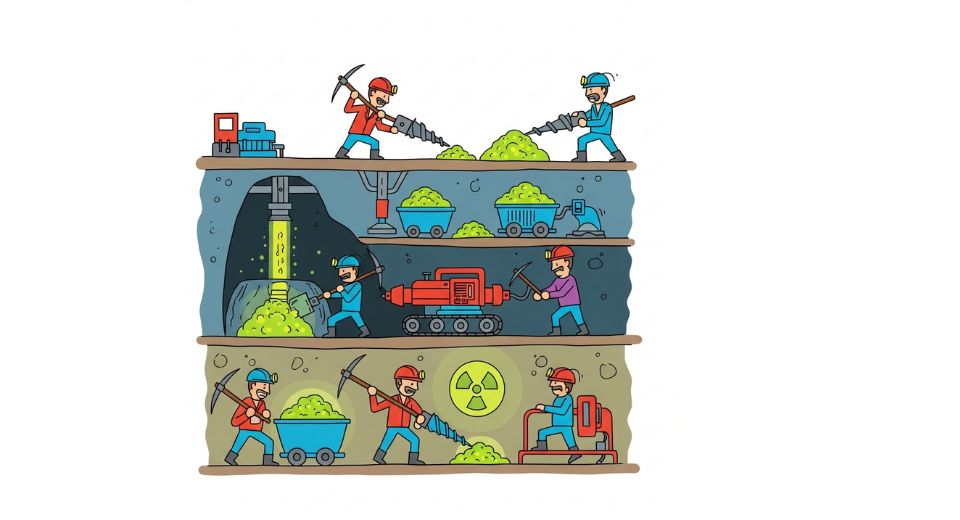
Jun 10, 2025

The mining and extraction of uranium have, over the years, been a necessary pursuit in the larger scope of energy development, and current findings by Metastat Insight point to the widespread and complex nature of the global uranium mining market. The industry, a key component to the development of nuclear energy production, continues to find its footing with the realities of economies of today and worldwide initiatives toward sustainable energy sources. Uranium mining is, in the bulk of energy resource discussions, little more than a mention. But the commodity is not one that can be disregarded for its sole unique function in the energizing of nuclear reactors and potential for reducing carbon emissions on a massive scale. The world market of uranium mining consists of numerous interconnected elements, with each factor adding to its expansion and operational complexities.
Its most fundamental role is the geographical allocation of uranium deposits. These nations include Kazakhstan, Canada, and Australia, which have controlled the world production level, where there are large deposits and up-to-date extraction methods that place these nations at an advantage. These nations are the foundation for a stable supply to meet the requirements of the world's nuclear power stations. But their operations differ from country to country depending on geology, regulations, and the state of the economy. That implies that the new technologies, approaches for better efficiency but with minimal effect on the environment, have become the mainstream in uranium mining. New methods such as in-situ leach mining are also embraced over conventional open-pit or underground mining, providing a more conservative option without subjecting the surrounding to drastic devastation.
These are also methods of safety and sustainability. However, adoption varies depending on the region due to varying factors like investment capability and degree of regulatory backing. All these technological developments achieved in recent years demonstrate industry commitment to marry improved productivity with respect for the environment. The broader energy market influences the uranium mining industry in many respects. Policy changes and alterations in public attitudes as well as energy source consumption trends lead to fluctuations in nuclear demand. Increased interest in nuclear as a complement to fossil fuels increases since the world has to shift in directions that mitigate carbon prints.
With increased demand for uranium primarily to fuel nuclear reactors also came increased demand for new capital to fund exploration and mining activities. This connection between uranium mining and nuclear energy ensures that energy policy shifts have major effects in the market. In spite of its promise, the uranium mining industry is confronted with significant challenges. Public opinion regarding nuclear power is sharply polarized, with safety issues usually taking the center stage. Historical nuclear accidents have given public confidence long-lasting blows, affecting the speed at which nuclear schemes are embraced or installed. There are also strict regulatory conditions in most regions of the globe that introduce complexities into mining activities.
This requires not just technological innovation but also open dialogue with stakeholders in order to generate confidence and reduce concerns. Economic considerations also decide the future of uranium mining. The cost involved in searching, digging, and processing can be relatively high and require massive investment and expertise. Uranium market price movement is driven by a demand-supply situation or a specific geopolitical factor, thus encouraging or deterring a new venture. Long-term thinking generally makes the ventures economical because one learns to deal with swings. Geopolitical considerations further shape the complexities of the uranium mining industry. The spatial concentration of uranium deposits means that its industry is thus susceptible to political unrest as well as global politics.
Import and export strategies, economic sanctions, and diplomatic negotiations may all impact the intercontinental and global movement of uranium and make waves across the entire global market. These geopolitical dimensions underscore the fact that cooperation is crucial in establishing stable and sustainable uranium supply chains.
Environmental sustainability remains a matter of serious concern for the uranium mining sector. Technological innovation has moderated some environmental issues, but mining is still problematic on the issues of land use, water use, and waste management. It would require dedication to best practices and adherence to extremely high environmental standards to address these issues. The future of the sector will therefore hinge on how it adjusts to achieve global sustainability goals. The global uranium mining market, according to Metastat Insight, is a sector that is simultaneously critical and dynamic. Its performance is closely linked to the energy requirements and environmental ambitions of the world. For this reason, the contribution of uranium mining is increasingly significant as the demand for renewable energy grows.
The economic, environmental, and social imperatives of industry will be in unimpeachable balance to guarantee that it endures throughout the years to come. Therefore, this market is exceptional and signifies the significance of this complex dynamic between energy production and worldwide attempts at sustainability.
Drop us an email at:
Call us on:
+1 214 613 5758
+91 73850 57479